
Clusters of galaxies are the largest objects in the Universe which are held together by their own gravity. The Universe was created by the Big Bang around 14 billion years ago. Luckily for us the gas that was created in the Big Bang was not distributed entirely smoothly. The early Universe contained ripples in the gas, which we can observe in the Cosmic Microwave Background (CMB). The ripples in density correspond to ripples in the temperature of the CMB by one part in 100,000; where hotter regions match denser regions. The denser regions began to collapse under their own gravity and separated from the expansion of the Universe. The densest regions then formed galaxies, which collide and merge as the cluster evolves. In simulations of the growth of structure show that the matter falls together along filaments, with voids in between. This matches the observed structure of the Universe as seen from surveys of the positions of galaxies.
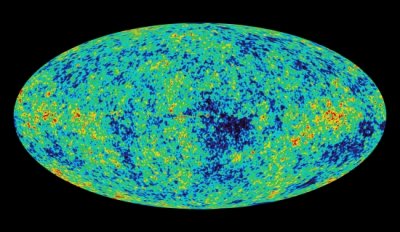 | 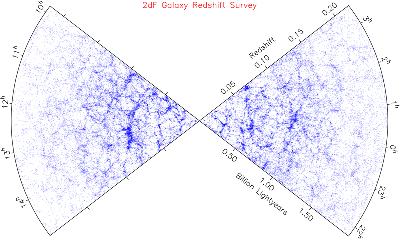 |
| The Cosmic Microwave Background as seen by the WMAP satellite. The red parts are regions that are hotter than average by 1 part in 10,000(Image courtesy, and these are the precursors to Clusters of GalaxiesWMAP) | The structure of the Universe measured from the redshifts (and hence distances) of galaxies. Clusters occur where the filaments meet. (Image courtesy 2dF collaboration) |
Simulations of the Universe reproduce this type of structure very well, see the Galaxy Formation at the Max Planck Institute for Astrophysics in Munich for some movies of their work
Clusters are the most massive objects in the Universe and because of this they attract large amounts of material from intergalactic space. This material falls towards the centre of the cluster gathering speed. At some point the particles collide and emit photons (thermal Bremsstrahlung), and as the speed at which the particles are moving is equivalent to a temperature of 10 million degrees, the photons are X-rays. X-rays were detected from a cluster of galaxies, M87 in the Virgo Cluster, in 1966. Comparing X-ray and optical images of clusters show that there is more matter in the gas between the galaxies then in the galaxies themselves.
They typically contain 100s to 1000s of galaxies and have sizes on the orders of 10 million light years. They are the largest objects in the Universe that have had the time to collapse under their own gravity. This means that they are still forming, which means that we can see how they formed, and also what conditions they formed out of.
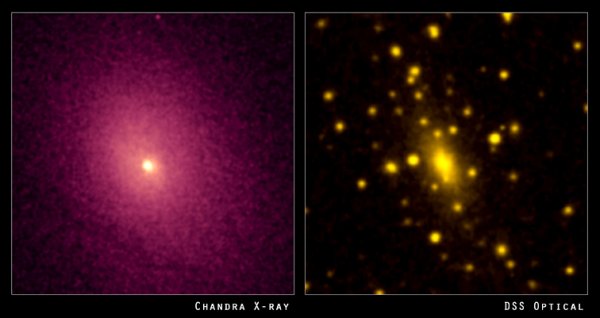 |
| The Abell 2029 cluster as seen by CHANDRA and HST. This shows how little structure can exist on large scales in clusters and also how much gas there is in the Intra Cluster Medium (ICM). (Image courtesy CHANDRA) |
X-ray line emission is also observed from clusters, which implies that there are elements present in the "Intra-Cluster Medium (ICM)" besides Hydrogen and Helium. The abundance of these elements correspond to about 1/3 of that seen in our Sun. The abundance changes with distance from the centre of the cluster. Processing of Hydrogen and Helium (which were formed in the Big Bang) in Stars is the only known way of creating new elements, and so this means that many Stars have their ashes in the ICM. Clusters are also sufficiently heavy so that they retain all the gas that falls into them. Therefore when stars explode, their ash is retained by the cluster, and this allows the evolution of the stars to be studied. In galaxies and stellar clusters the death throws of a star can give the gas enough energy so that it can escape and so is lost.
Most of the mass in clusters cannot be seen in visible light or in X-rays. Around 1-2% of the mass comes from Stars, ~11% from the gas in between the galaxies in the cluster - the Intra-Cluster Medium, and the remainder, 85-87%, is Dark Matter. The radiation emitted from a cluster comes from a very small fraction of the mass present. Clusters are therefore provide good evidence for the existence of Dark Matter. They are also very large, and so can be regarded as representative of the Universe as a whole, and so using information from Clusters astronomers can estimate Cosmological quantities, such as the expansion rate of the universe.
Einstein's Theory of General Relativity states that anything with mass bends Space-Time. This distortion of Space-Time results in gravity, but also means that massive objects bend light. For a detectable bend in the direction that light is taking the object has to be very heavy. The Sun causes a deflection in the position of stars (as would be seen close to the solar disc during an eclipse) of 2 arcseconds (1 arcsecond = 1/3600 degree).
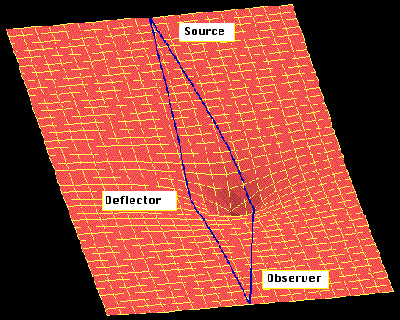 |
| The deflection of Space-Time by a mass; like a rubber sheet with a cannon-ball on it. |
Clusters of galaxies are much heavier and so they bend light to a much greater extent. In some cases the cluster happens to sit between a very distant galaxy and ourselves such that the light from the distant galaxy is magnified. This process also distorts the shape of the galaxy into streaks and arcs. Where these images fall in the cluster allows astronomers to calculate the mass of the cluster in a different way. Lensed galaxies are amongst the most distant objects known.
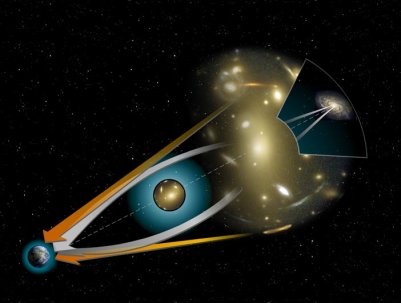 | 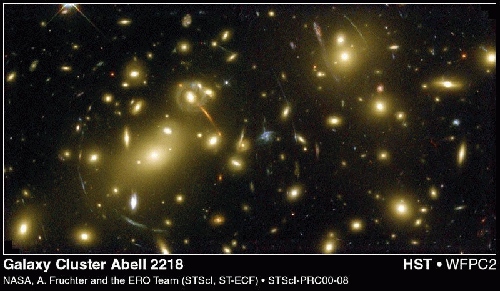 |
| How a gravitational lens works. | Hubble Space Telescope Image of Abell 2218 showing a range of gravitationally lensed features. (Image courtesy NASA) |
BACK: ULX's UP: X-ray Research Topics NEXT: Radio & X-ray Interactions